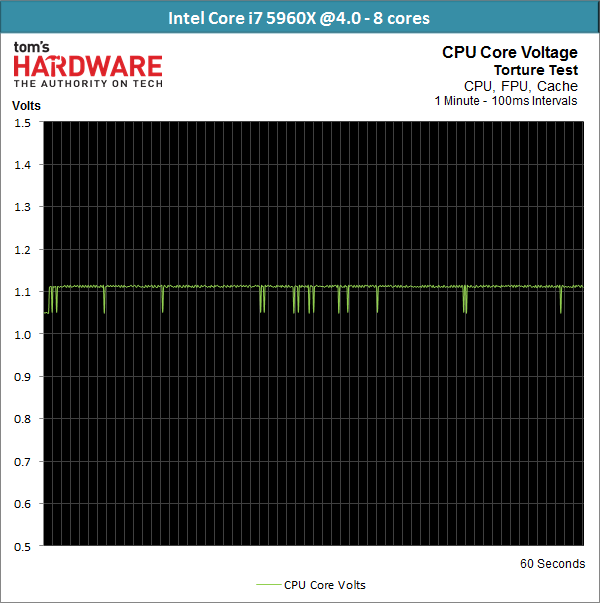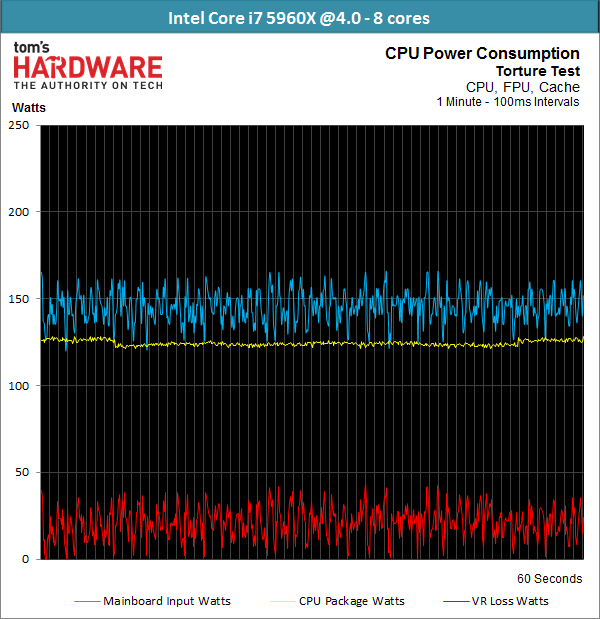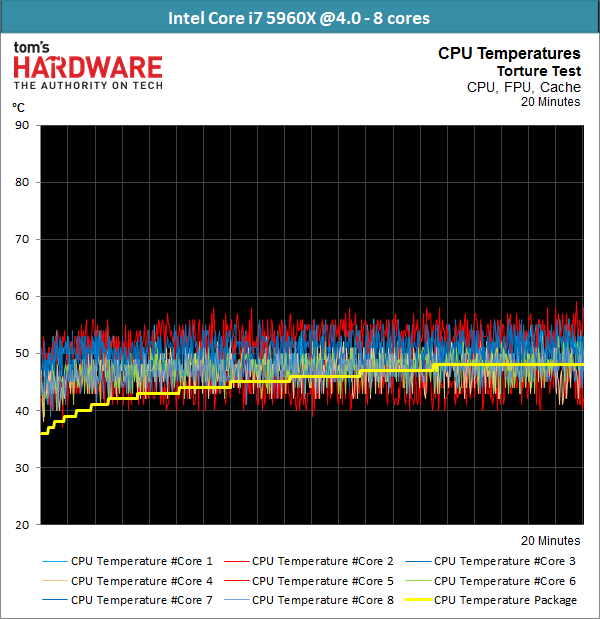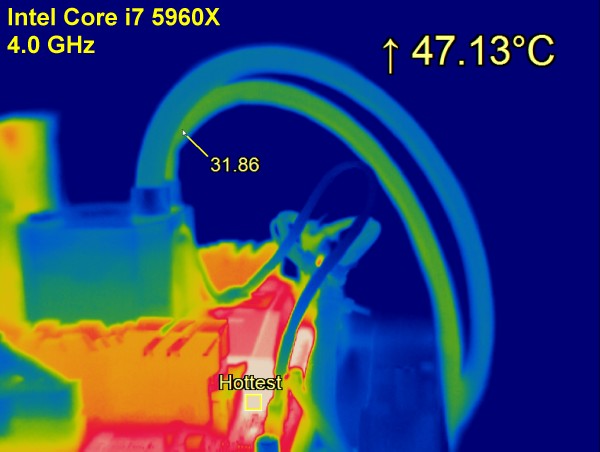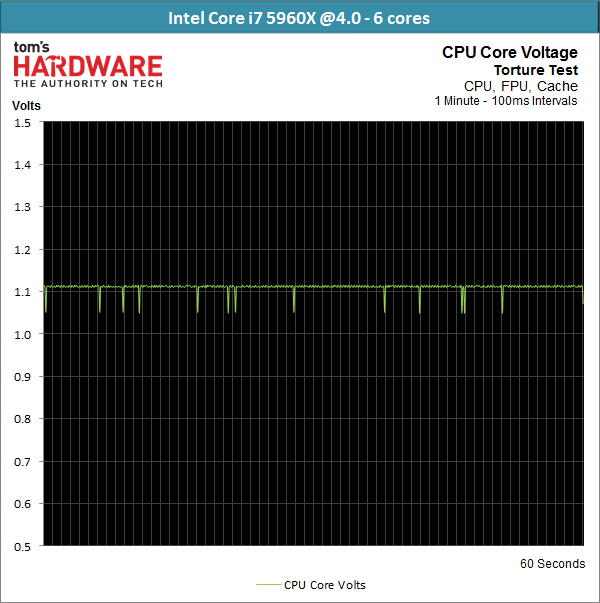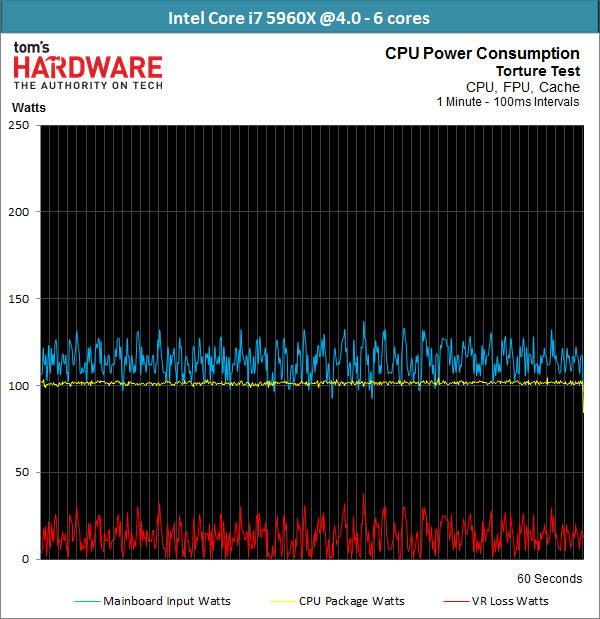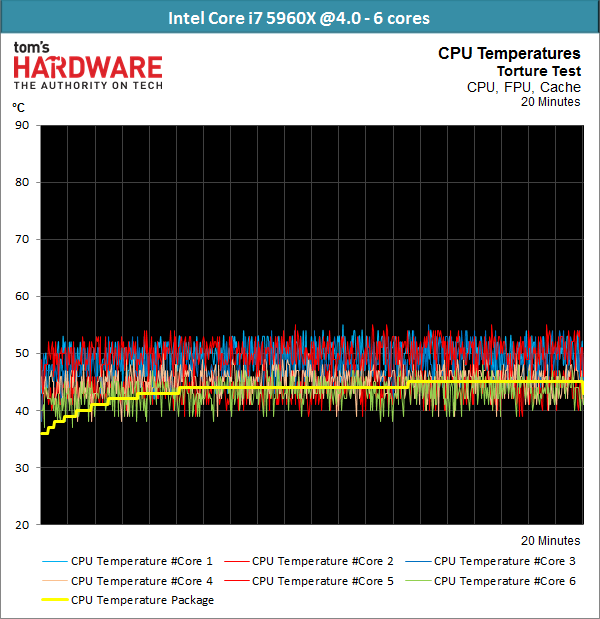Intel Core i7-5960X, -5930K And -5820K CPU Review: Haswell-E Rises
Power, In Depth: Eight and Six Cores at 4 GHz
Core Voltage
Overclocked to 4 GHz, our Core i7-5960X's core voltage is now 1.110 V. This time around we're optimizing it manually to minimize power consumption and temperature.
Power Draw
The following chart contrasts the VRM's measurement with our reading at the EPS connector, in addition to power losses due to the voltage regulation circuit.
A reading of 18 W at idle is identical to what we just saw at 3.5 GHz. However, the increase to 124 W under load shows that the eight-core configuration running at 4 GHz is starting to pull quite a bit more power from the wall.
Still, these figures are within reason considering the performance you get in return.
| Power Consumption | Average Idle | Maximum, 100% Load | Average, 100% Load |
|---|---|---|---|
| CPU 12 V In | 22 W | 165 W | 146 W |
| CPU Package | 18 W | 128 W | 124 W |
| VRM Loss | 4 W | 43 W | 23 W |
Temperatures
The temperatures at idle don't increase. And as clock rate goes up, the difference between each core's minimum and maximum temperature becomes more pronounced, too.
It’s time for a look at the time-lapse video.
| Temperature T | Idle | Maximum, 100% Load | Average, 100% Load (Heated Up) |
|---|---|---|---|
| Core | 27 °C | 57 °C | 48 °C |
| Package | 29 °C | 48 °C | Row 1 - Cell 3 |
| Water (In / Out) | 24 °C / 27 °C | 32 °C | Row 2 - Cell 3 |
| VRM | 34 °C | 47 °C | Row 3 - Cell 3 |
Six Cores At 4 GHz
Again, we want to try the same thing using six cores to estimate how the Core i7-5930K or -3820K might behave.
Get Tom's Hardware's best news and in-depth reviews, straight to your inbox.
Core Voltage
Registering 1.100 V, there’s barely any difference in CPU core voltage between the six- and eight-core models.
Power Draw
Disabling two cores yields a reduction in power consumption to 17 W at idle (21 W if you count the VR) and 101 W under load. That's notably less than the eight-core configuration.
| Power Consumption | Average, Idle | Maximum, 100% Load | Average, 100% Load |
|---|---|---|---|
| CPU 12 V In | 21 W | 137 W | 115 W |
| CPU Package | 17 W | 105 W | 101 W |
| VRM Loss | 4 W | 32 W | 14 W |
Temperatures
Here are the temperatures under load:
| Temperature T | Idle | Maximum, 100% Load | Average, 100% Load (Heated Up) |
|---|---|---|---|
| Core | 27 °C | 53 °C | 46 °C |
| Package | 28 °C | 44 °C | Row 1 - Cell 3 |
| Water (In / Out) | 24 °C / 27 °C | 31 °C | Row 2 - Cell 3 |
| VRM | 34 °C | 45 °C | Row 3 - Cell 3 |
Our eight- and six-core setups increase about 20 W when we overclock to 4 GHz. It's easy to see that we're operating Haswell-E above its sweet spot. Nevertheless, you should be able to hit a stable overclock at comparable performance levels using a big heat sink. Just be sure you have a high-end cooler and a chassis with good airflow.
Current page: Power, In Depth: Eight and Six Cores at 4 GHz
Prev Page Power, In Depth: Eight and Six Cores at 3.5 GHz Next Page Power, In Depth: Eight and Six Cores at 4.5 GHz-
B4vB5 Chris and Igor @ TomsHW,Reply
Bit disappointed to not see a comparison with the Xeon E5-1650v2(or 1660v2), as the 2600 is a bit overkill comparing prices. Some of us just need a workstation with ECC ram and not just a free-for-all(ie someone else is paying) Xeon 2600 fest. -
JamesSneed Out of curiosity why were so many of the gaming tests only done at 2560x1440? Seems like you would be more GPU bound at this resolution. I'm not sure it really matters but I do like gaming at 1080p for the very high frame rates was curious if these would push frame rates higher. Otherwise nice review.Reply -
ohim Reply14063555 said:Affordable 8-cores from Intel are finally coming. Awesome.
1000$ is affordable to you ? :))
14063653 said:Out of curiosity why were so many of the gaming tests only done at 2560x1440? Seems like you would be more GPU bound at this resolution. I'm not sure it really matters but I do like gaming at 1080p for the very high frame rates was curious if these would push frame rates higher. Otherwise nice review.
Though you have a point here, the guy buying such CPUs most likely will game at above 1080p .. but this would have implied using 2 GPUs at least in the test. -
chiefpiggy Why do they call these their "5th generation" of Intel core processors if they're refreshes of the Haswell processors? I get that they have revolutionary technology within but with the release of broadwell so soon I doubt that anyone would buy these processors..Reply -
envy14tpe I need this system to play Minecraft. with that aside, Intel finally has made a jump in i7s value and performance.Reply -
srap "Single-threaded software is so last decade, though."Reply
I have a hunch that we will never see anything like this in the comment sections of AMD reviews. Not sure why :D -
CaptainTom Yeah the real winner of a cpu here is definitely the 5820K. If I were building now, that is what I would use.Reply
